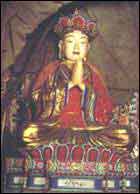| About China > History > Celebrities |
|
|
Tang Seng
The ancient Chinese mythological novel Xi You Ji (Pilgrimage to the West) made the story of Tangseng well known in China for centuries. It was based on a true story of a famous Chinese monk, Xuanzang (602-664).
Xuanzang became a monk at the age of 12 and became a monk at the age of 21. He absorbed in the study of the Sacred Books from India and mastered Buddhist doctrines and principles. But Xuanzang was not satisfied with his progress and traveled to many places in China to study from other monks. As he studied Buddhist teachings, the different translations confused him. He decided to journey to India. There he could study original versions of the Buddhist teachings and talk with other Buddhist monks in order to understand the errors and conflicts in the Chinese translations of Buddhist writings.
Xuanzang set off from Chang'an (today's Xi'an City) on his journey to the west in 629. He traveled along what we now know as the Silk Road including the Xinjiang Autonomous Region, central Asia and so on and eventually reached India. Everywhere he went, Xuanzang received warm welcome and respect. Xuanzang visited Buddhist resorts in different countries and absorbed their cultures. In 645 Xuanzang returned to Chang'an with canons, Buddha statues, relics and so on.
The rest of Xuanzang's life was spent in teaching, promulgating and translating Buddhism at Da Ci'en (great mercy) Temple in Chang'an. He translated 75 works of Buddhist classics in 1,335 volumes into Chinese and translated Laozi (a work of Laozi, the founder of Taoism) and Mahayana Shraddhotpada Shastra (Treatise on the Awaking of Faith in Mahayana) into Sanskrit, which were later introduced to India. Xuanzang's translation and teaching made Chang'an the center of Buddhism in the world.
Xuanzang's Report of the Regions West of Great Tang provided important information about the peoples and lands of central Asia, India, Nepal and Pakistan in the seventh century and remained an invaluable account of seventh-century India such as the summary of Indian geography, which reflected the territory of India during the period. Indian Buddhism influenced Chinese literature greatly. Indian paintings, Buddha statues and temple construction helped to improve the levels of Chinese arts such as painting, sculpture, construction and music. Xuanzang played an important role in the Sino-foreign communications.
Xuanzang was very concerned about Buddhist education and recruited many eminent disciples including Japanese and Korean, who spread Chinese Buddhism to their motherlands. |
||||
 |
